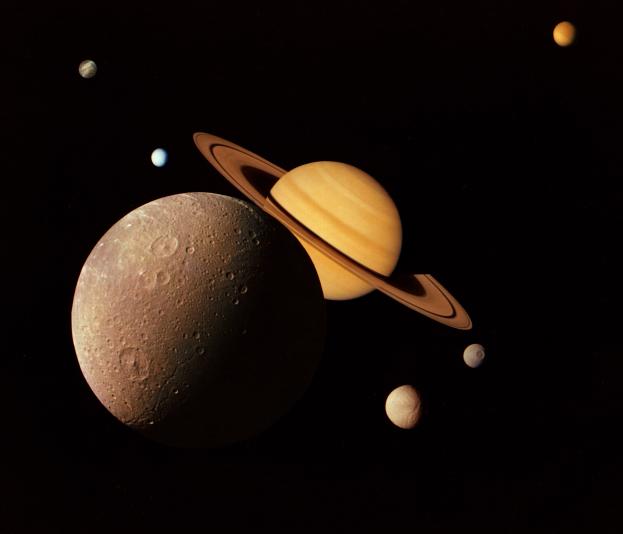Saturn Moons

Saturn has a large number of moons, 49 are currently confirmed, 34 of which have names. The precise figure will never be certain as the orbiting chunks of ice in Saturn’s rings are all technically moons, and it is difficult to draw a distinction between a large ring particle and a tiny moon.
Saturn’s most noteworthy moon is Titan, the only moon in the solar system to have a dense atmosphere. Due to the tidal forces of Saturn, the moons are currently not at the same position as they were when they were first formed.
Saturn’s Opposition Periods 2001–2005
| Date of Opposition | Distance to Earth (AU) | Angular diameter |
| December 3, 2001 | 8.08 | 20.6 arcsec |
| December 17, 2002 | 8.05 | 20.7 arcsec |
| December 31, 2003 | 8.05 | 20.7 arcsec |
| January 13, 2005 | 8.08 | 20.6 arcsec |
Appearance
| Stationary, retrograde | Opposition | Distance to Earth (AU) | Maximum Brightness (mag) | Diametre | Inclination of ring | Stationary, prograde | Conjunction to Sun |
| October 26, 2003 | December 31, 2003 | 8.05014 | -0.5 | 20.70″ | -25,5° | March 7, 2004 | July 8, 2004 |
| November 8, 2004 | January 13, 2005 | 8.07564 | -0.4 | 20.64″ | -22,8° | March 22, 2005 | July 23, 2005 |
| November 22, 2005 | January 27, 2006 | 8.12682 | -0.2 | 20.51″ | -18,9° | April 5,2006 | August 8, 2006 |
| December 6, 2006 | February 10, 2007 | 8.20033 | 0.0 | 20.32″ | -13,9° | April 20, 2007 | August 21, 2007 |
| December 20, 2007 | February 24, 2008 | 8.29136 | 0.2 | 20.10″ | -8,4° | May 3, 2008 | September 4, 2008 |
| January 1, 2009 | March 8, 2009 | 8.39440 | 0.5 | 19.85″ | -2,6° | May 17, 2009 | September 17, 2009 |
| January 14, 2010 | March 22, 2010 | 8.50379 | 0.5 | 19.60″ | 3,2° | May 31, 2010 | October 1, 2010 |
| January 27, 2011 | April 3, 2011 | 8.61392 | 0.4 | 19.35″ | 8,7° | June 14, 2011 | October 13, 2011 |
Saturn
Saturn is the sixth most planets starting from the Sun. It is a gas giant, the second-largestplanet in the solar system after Jupiter. Saturn has large rings consisting of mostly ice particles with a smaller amount of rocky debris. It was named after the Roman god Saturn. Its symbol is a stylized representation of the god’s sickle.
Physical Characteristics of Saturn
Saturn‘s shape is perceptibly flattened at the poles and bulging at the equator (an oblate spheroid) its equatorial and polar diameters vary by almost 10% (120,536 km vs. 108,728 km). This is the result of its rapid rotation and juicy state. The other gas planets are also oblate, but to a lesser degree. Saturn is also the only one of the Solar Systems planets less dense than water, with an average specific density of 0.69. This is only an average value, however; Saturn’s upper atmosphere is fewer dense and its core is significantly denser than water.
Saturn’s interior is like that of Jupiter’s, having a rocky core at the center, a liquid metallic hydrogen layer above that, and a molecular hydrogen layer above that. Traces of various ices are also present. Saturn has a very hot interior, reaching 12000 K at the core, and it radiates more energy into space than what it receives from the Sun. Most of the extra energy is generated by the Kelvin-Helmholtz mechanism, but this alone may not be sufficient to explain Saturn’s heat production.
Saturn Rotation and Revolution
Since Saturn does not turn around on its axis at a uniform rate, two rotation periods have been assigned to it, like in Jupiter’s case: System I has a period of 10 h 14 min 00 s (844.3°/d) and encompasses the Equatorial Zone, which extends from the northern edge of the South Equatorial Belt to the southern edge of the North Equatorial Belt.
All other Saturnian latitudes have been assigned a revolving period of 10 h 39 min 24 s (810.76°/d), which is System II. System III, based on radio emissions from the planet, has a period of 10 h 39 min 22.4 s (810.8°/d); because it is very secure in value to System II, it has largely superseded it. While approaching Saturn in 2004, the Cassini spacecraft found that the radio rotation period of Saturn had increased slightly, to approximately 10 h 45 m 45 s (± 36 s). [2] The cause of the change is unknown.
Saturn is probably best famous for its planeary rings, which make it one of the most visually remarkable objects in the solar system.
Solar System | Mercury | Venus Moons | Earth | Mars Moons | Jupiter Moons | Saturn Moons | Uranus Moons | Neptune Moons | International Space System | ISS Research | Moons of the planet | Magnetosphere | Regions Of Comets | Space Station Glossary | Space Station Abbreviation | Space Station Sitemap | Asteriods | Contact Us